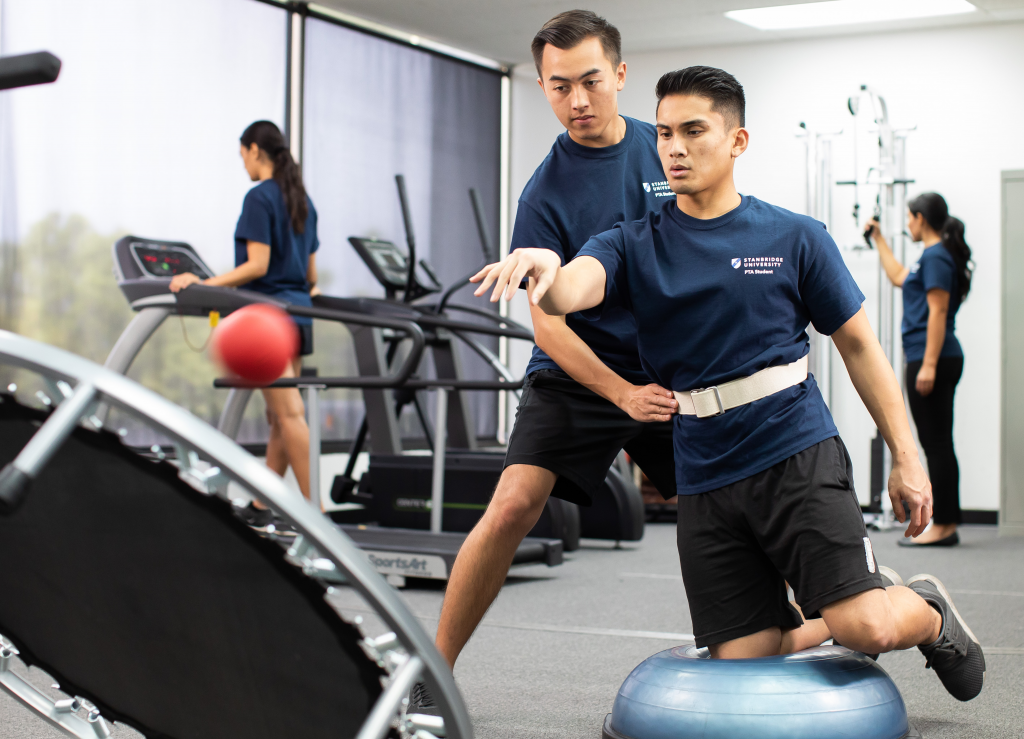PTs vs PTAs: What’s the Difference?
Are you thinking of becoming a physical therapist assistant (PTA)?
According to the Bureau of Labor Statistics, it’s a career choice that can offer you stability, job satisfaction, and opportunities for growth.1 But what are the differences between being a physical therapist (PT) and a PTA?
Physical therapist assistants and physical therapists both work in the field of physical therapy, but there are some key differences between the two professions. In this blog post, we’ll explore the roles and responsibilities of both careers, so you can make an informed decision about which path is right for you and have a general idea of what to expect.
Physical Therapists vs. Physical Therapist Assistants: Responsibilities
PTs and PTAs work together to provide physical therapy services. Both roles are vital to the care of patients, but they have different responsibilities.
As stated by the Bureau of Labor Statistics, physical therapists are responsible for a wide range of patients, from those recovering from surgery to those dealing with chronic pain. They must be able to quickly assess each patient’s needs and develop an individualized plan of care. In addition to providing hands-on therapy, physical therapists also need to be able to effectively communicate with patients and their families. They must provide support and encouragement while also monitoring the progress of their patients.2
Physical therapist assistants work closely with physical therapists to carry out treatment plans that improve their patients’ quality of life. PTAs may provide hands-on therapy such as manual treatment and stretching, but they also perform administrative tasks such as scheduling appointments and documenting patient progress. Other responsibilities may include educating patients and families about their condition and communicating patient progress to physical therapists.2 Whether they’re working in a hospital, outpatient clinic, or long-term care facility, PTAs play an important role in helping patients reach their goals.
PTs vs. PTAs: Work Settings
PTs and PTAs work in a variety of settings, including hospitals, outpatient clinics, private practices, home health agencies, schools, nursing homes, and fitness centers.1 PTs and PTAs may also work in industrial or corporate settings, such as physical therapy departments within companies.
The type of setting where a PT or PTA works will often depend on their area of specialization or the population they work with. For example, PTs who specialize in geriatrics may work in a nursing home setting.
Education and Training
Physical therapists need to earn a Doctor of Physical Therapy (DPT) degree.
If you’re interested in working as a physical therapist assistant, you’ll need to complete an accredited associate degree program. These programs usually last two years and feature coursework in anatomy, therapeutic exercise, and kinesiology, as well as hands-on training during supervised clinical work.1
Job Outlook
According to the Employment Development Department of the State of California, statewide employment for physical therapists is expected to grow 22.4% from 2018 to 2028.3 For physical therapist assistants, statewide employment is expected to grow 28.8% in the same time frame.4
Benefits of a PTA Career
A PTA degree can be earned in two years, which may help you enter the healthcare workforce more quickly, as opposed to pursuing a bachelor’s and doctorate program.
Despite having “assistant” in the title, physical therapist assistants still have autonomous duties. They participate in the direct care of patients, treating them with manual and therapeutic techniques and reporting results to the physical therapist.1
Physical therapists and physical therapist assistants both play important roles in helping people regain mobility and live active, independent lives. With the aging of the Baby Boomer generation and the increased prevalence of obesity and chronic diseases such as diabetes, the demand for physical therapy services is expected to continue to grow in the coming years.1
Physical Therapist Assistant Program at Stanbridge University
Thinking of stepping up to help meet that demand? Learn more about Stanbridge University’s Physical Therapist Assistant program.
Frequently Asked Questions
Physical therapists assess patients, create individualized care plans, and provide treatment.2 PTAs help carry out those plans under the direction of a PT, assisting with therapy, documentation, and patient education.1
Both PTs and PTAs may work in hospitals, outpatient clinics, home health, schools, nursing homes, and private practices. They can also work in wellness or industrial settings. 1,2
PTs must earn a Doctor of Physical Therapy degree from an accredited program.2 PTAs complete an accredited associate degree program that includes classroom instruction and supervised clinical training.1
In California, employment for Physical Therapist Assistants (PTAs) is projected to grow in the coming years, showing strong demand across hospitals, outpatient clinics, and long-term care facilities. Job opportunities for Physical Therapists (PTs) are also expected to remain steady, with demand driven by the need for rehabilitation services statewide. ³,4
It typically takes about two years to become a PTA.1 Becoming a PT takes longer, as it requires a bachelor’s degree followed by three years in a Doctor of Physical Therapy program.2
PTAs can enter the field more quickly and start making an impact in patient care. The role includes hands-on work with clients in a variety of healthcare settings such as hospitals, outpatient clinics, home health, and schools, with fewer years of training.1
1Source: Bureau of Labor Statistics, U.S. Department of Labor, Occupational Outlook Handbook, Physical Therapist Assistants and Aides, https://www.bls.gov/ooh/healthcare/physical-therapist-assistants-and-aides.htm. As viewed on November 10, 2022.
2Source: Bureau of Labor Statistics, U.S. Department of Labor, Occupational Outlook Handbook, Physical Therapists, https://www.bls.gov/ooh/healthcare/physical-therapists.htm. As viewed on November 10, 2022.
3Source: Employment Development Department, State of California, Occupation Profile, Physical Therapists, https://www.labormarketinfo.edd.ca.gov/cgi/databrowsing/occExplorerQSDetails.asp?searchCriteria=physical+therapist&careerID=&menuChoice=localAreaPro&geogArea=0601000000&soccode=291123&search=Explore+Occupation. As viewed on November 10, 2022.
4Source: Employment Development Department, State of California, Occupation Profile, Physical Therapist Assistants, https://www.labormarketinfo.edd.ca.gov/cgi/databrowsing/occExplorerQSDetails.asp?soccode=312021. As viewed on November 10, 2022.
